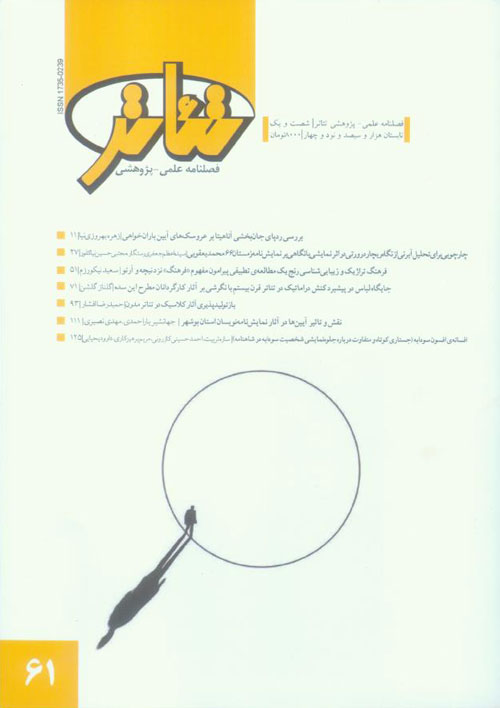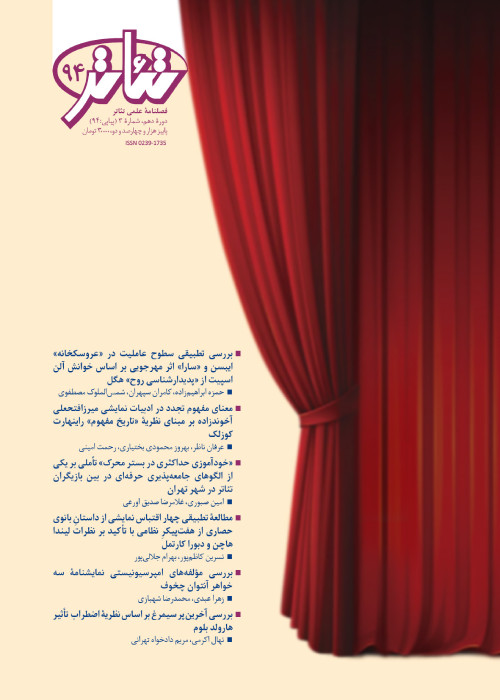فهرست مطالب

نشریه تئاتر
سال دوم شماره 61 (تابستان 1394)
- 152 صفحه، بهای روی جلد: 80,000ريال
- تاریخ انتشار: 1394/12/20
- تعداد عناوین: 8
-
-
صفحه 7
-
Page 11Rainmaking ritual is one of the most important rituals, remaining from the past. now a day, tis ritual is done in so many Iranian cities in order to ask for rain in various forms. the main element of this ritual, are dolls made by people asking for rain. present research tries to study the effects of goddess Anahita animation on dolls of rainmaking ritual. present article we first studied Goddess Anahita and her place in ancient Iran by studying previews studies of researchers and mythologists and then she was matched with the Babylons goddess Ishtar to consider the way these goddesses were moved by people in past. then, the rainmaking ritual was studied and we had a brief look on role and place of these dolls in such rituals. finally, we studied the relation of rainmaking rituals dolls with goddess Anahita and effect of this goddess on the look and movement of these dolls is proved.Keywords: Doll, Anahita, Ishtar, Rainmaking Ritual
-
Page 27Richard Rorty is one of the contemporary effective ponderings, by defining Irony as a tool to re-define and re-describe the individual and his/her peripheral world. He emphasized role of literature and art as a medium to implement Irony. Therefore the man of literary achieves self-creation in private sphere and solidarity in public sphere. Dramatic literature among varied types of arts is as successful combination of arts and literature that provides dramatic conversation as a medium to define and characterizing present concepts and humanistic issues in new ways. Thus it shows the ways to live better to the contemporary human. This research has tried to introduce a framework which through that one can by taking advantage of components and especial elements of the drama, investigate and analyze Irony during a drama work. Also this research shall pinpoint consideration of sample elements of defined format in is drama "66's winter" Mohammad Yaghubi, the active and popular dramatist of the time being.Keywords: Irony, Analyzing of Dramatic Work, Framework, Richard Rorty, Mohammad Yaghubi
-
Page 51This article attempts to achieve an aesthetic definition of the concept of culture through a comparative study of Nietzsche and Antonin Artaud's ideas. What we call "tragic culture" in this article is the result of Nietzsche and Artaud's approaches in finding the aesthetic patterns of ancient Greek tragedies and theater of cruelty. From the perspective of the authors of this article what drives Artaud and Nietzsche to is the approach that theater evokes in justifying the nature of "suffering" through the tragic and the concept of cruelty. On this basis it can be said for Nietzsche and Artaud theater acts as a model to justify the existence aesthetically. The model, with an aesthetic justification of suffering, transforms it to a source of tragic pleasure and consequently undermines it inside an organic unity. More than anything else this research tries to answer the question as to why does an aesthetic justification of life presents itself in seemingly pessimistic concepts such as pain, misery, conflict and the tragic? But the ultimate goal of this appear is to explore a culture that is on the basis of such a perspective, i.e. the aesthetic justification of life and stands against the culture that tries to reduce life to a partial and ideological and subjective element. So in the end, in addition to a comparative study, we will see that the unity that exists in the modern culture is a false unity imposed by an external element on life and that the true meaning of culture deems an internal unity like the generic unity of the work of art linked to the aesthetic justification of existence. This research is based on library resources and particularly focusing on the books The Birth of Tragedy and the theatre and its double tries to explain the quality of this culture in the pattern of a form of "Action", "Pluralism" and "Yes Saying" to life and to the "New".Keywords: theatre of cruelty, tragic culture, aesthetics, suffering, Nietzsche, Artaud
-
Page 71There is no doubt that the costume in theater is an essential part of any performance . the costume is a part of the performer(actor/actress) itself which presents a unified image . This essay intends to define the position of costume in progressing and developing dramatic action. With a short glance to the works of the eminent costume designers and Directors and Movements which had an effect on costume design such as symbolism, realism, naturalism, futurism, constructivism and,,, of the past century, this research tends to have an in-depth survey on the status, importance and influence of costume design and its power to enhance the flow of the dramatic action, in the twentieth centurys (Western) theater The method here is descriptive-analytic which falls into the category of applied researches. First we primarily define the role of costume in theater. Then we take a look into the position of costume in theater from ancient Greece to 19th century and finally we study costume in works of 20th centurys famous directors and designers.Keywords: costume in theatre, dramatic action. 20th century
-
Page 93Since the enlightening era, theater has served as a setting for reemergence and representation of philosophical notions. A historical interchangeability between philosophy and myths apparently motivated theater in the post-enlightening era to start to reflect myths and traditions in its dramatic structure one way or another. The present article aims to examine the technical replicability of classic works in modern theater following the critical views of Walter Benjamin. It also aims to be a review of the philosophers views. Though Benjamin never directly debates theater, his views cover so extensive an area in art that one can trace and redefine the 20th centurys theater based on his literature and thoughts. Benjamin not only seeks to reveal the debilitative aspects of the modern instrumentalist rationalism but also aims to criticize the dark side of the modern time as a modern subject. In this sense, modern author as knowing subject takes modern works as object of knowledge and seeks to review or replicate the works as dialectic matters between traditional sense and its modern sense in a way that modern human could realize it in a replicated sense. The main aim of the study is to bridge a given gap between a work of art and its audience. The aim may help establish a bond between traditional and sectarian values of art and eventually imbue the field of art with value of life, a value that Benjamin considers as inevitable for modern human to embrace.Keywords: Technical reproducibility, classic works, modern theater, Walter Benjamin
-
Page 111Bushehr province with the especial geographical location is full of rituals. The
rituals which rooted in peoples lives and the inhabitants of this region are living
with them. According to the abundance of dramatic indicators in rituals of this
province, local playwrights had used these rituals in their works. But the important
question is, did the authors created deserved works due to these rituals or
not? This article attempts to have a general look over dramatic literature and
rituals of Bushehr province and also tries to investigate the impact or lack of
impact on dramatic literature of this region.Keywords: Ritual, Dramatic literature, Bushehr province, Culture, Play writing -
Page 125Considering the latest analysis made on the story of Syavosh and Soodabeh by the critics, it has been quite unfortunate to know that it is Soodabeh who has been accused, as if all the anonymous story tellers have given hand in hand toaccuse her of all the mishaps without considering the fact that what has happened to this woman has its roots in her deep affection though from her sensual desire- and consequently her failure with love. In addition, analysts have paid little attention to the environment in which the personality of Soodabeh has been raised and brought up, maybe because the story tellers have ignoredthe role of environment in developing Soodabehs character. In this article an attempt has been made to focus on the role men, environment, and fate has had on the iniquities of Soodabeh that might have reduced the burden of her sin. For the purpose of that , in this article which is based on library data collection and based on descriptive-analytic method, a summary of the story will be touched on and then an analysis of Soodabeh's character will be dealt with.Keywords: Shahnameh, Soodabeh, Syavosh, keykavoos


